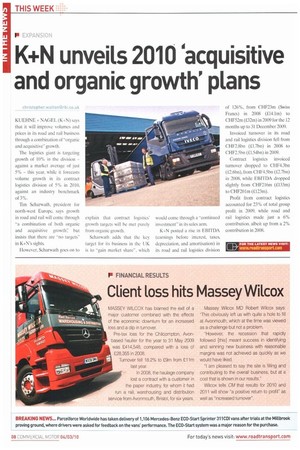K+N unveils 2010 'acquisitive and organic growth' plans
Page 8

If you've noticed an error in this article please click here to report it so we can fix it.
christopher.wattonfarbi.Muk
KUEHNE NAGEL. (K ) say, that it will improve volumes and prices in its road and rail business through a combination of "organic and acquisitive" growth.
The logistics giant is targeting growth of 10% in the division — against a market average of just 5% — this year, while it forecasts volume growth in its contract logistics division of 5% in 2010, against an industry benchmark of 3%.
Tim Scharwath, president for north-west Europe, says growth in road and rail will come through 'a combination of both organic and acquisitive growth': but insists that there are "no targets" in K+N's sights.
lowever. Seharwath goes on to explain that contract logistics' growth targets will he met purely from organic growth.
Scharwath adds that the key target for its business in the UK is to "gain market share" which would come through a "continued investment" in its sales arm.
K+N posted a rise in EBITDA (earnings before interest, taxes, depreciation, and amortisation) in its road and rail logistics division
of 126%, from CHF23m (Swiss Francs) in 2008 (£14.1m) 10 CHF52m (92m) in 2009 for the 12 months up to 31 December 2009.
Invoiced turnover in its road and rail logistics division fell from CHF2.8bn (1:1.71m) in 2008 to CHF2.5bn (£1.54bn) in 2009.
Contract logistics invoiced turnover dropped to CHF4.3bn (12.6bn), from CH I-4.5bn (£2.7bn) in 2008, while EBITDA dropped slightly from CHF216m (£133m) to CHF201m (£123m).
Profit from contract logistics accounted for 23% of total group profit in 2009. while road and rail logistics made just a 6% contribution, albeit up from a 2% contribution in 2008,
































































































































